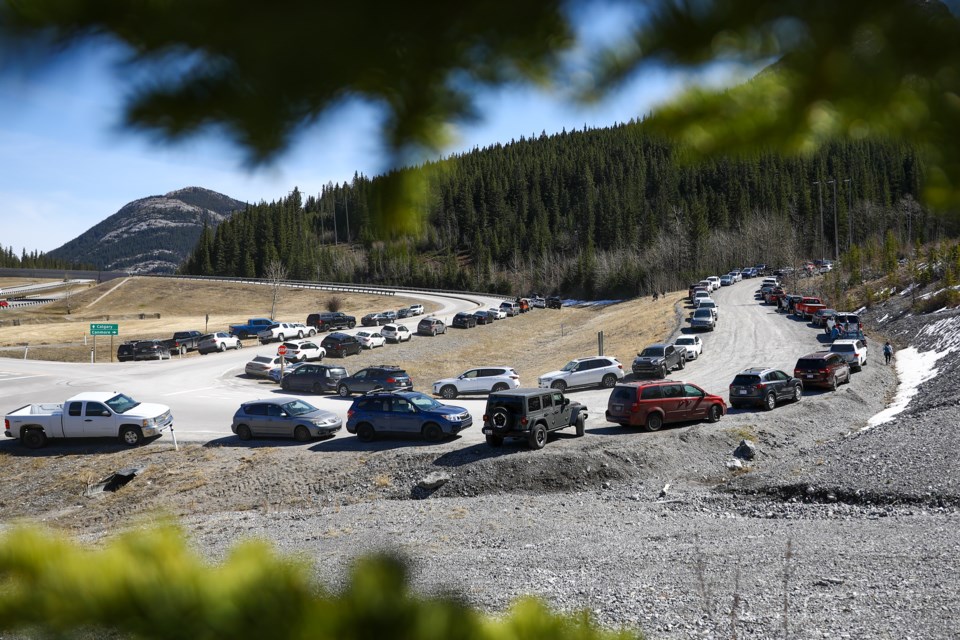KANANASKIS COUNTRY – The new user pass for Kananaskis Country has raised just shy of $10 million so far.
Introduced on June 1, the so-called Kananaskis Conservation Pass aimed to bring in additional dollars to provincial coffers to offset costs of conservation efforts, search and rescues, services and infrastructure after record visitation in 2020 strained the protected area’s resources and wildlife.
Crowds fill campsites, more cars cause traffic jams while viewing wildlife, hiking trails are busier than ever and vehicles spill onto highways as parking lots reach capacity at some of the more popular destinations.
“Over the past two years, visitation to Kananaskis Country has increased by 32 per cent,” said Tim Kulak, a spokesperson for AEP.
“So far this year, Kananaskis Country has seen more than three million visitors, with more than five million visiting in 2020.”
AEP reports that 250,000 Kananaskis conservation passes – which are required for vehicles parked at provincial park and public land sites in K-Country and the Bow Valley – have been issued, generating approximately $9.9 million in revenue.
A day pass costs $15 per vehicle, or a yearly pass that allows for two vehicles to be registered under the same pass rings in at $90.
When the Kananaskis conservation pass was introduced, the Alberta government projected it would generate $15 million in revenue in its first year.
“We are on track to achieve that target,” Kulak said.
Kulak said all revenue generated will be used to improve the overall visitor experience in Kananaskis and will pay for trail maintenance, search and rescue operations, visitor services and the upkeep of facilities at day-use areas and campgrounds.
“The fee is also going toward increasing on-the-ground education and enforcement with additional conservation officers,” he said.
Kulak said routine spot checks indicated compliance rates for the pass are over 80 per cent.
“Over the summer months, department staff were focused on raising awareness and providing Albertans with information to promote compliance,” he said.
Kulak said the decrease in visitation to K-Country this year in comparison to 2020 could be attributed to a number of factors such as weather or the introduction of the conservation pass, which encourages carpooling and aims to reduce the number of cars.
“We had more favourable weather conditions in 2020 than in 2021,” said Kulak, referring to the blistering hot record temperatures throughout much of the summer and smokey skies from wildfires in neighbouring British Columbia.
In addition, Kulak said travel restrictions resulting from COVID-19 prevented Albertans from visiting several other provinces and countries, leading to more travel within the province in 2020.
“There may also be a slight return to more normal levels of visitors,” he said. “For example, in 2019 there were 4.1 million visitors to the area, in 2018 it was 3.8 million.”
Since 2013, the province has spent more than $160 million in Kananaskis Country, including $9 million to upgrade William Watson Lodge; $880,000 to fix Ha Ling Trail, one of the most popular trails in the province, and $16 million to repair damage to the Kananaskis Country Golf Course after most fairways and greens were damaged or destroyed in the 2013 floods.
In neighbouring Banff National Park, summer visitation to was slightly higher than the same period for June, July and August last year, but slightly lower than the last pre-pandemic summer season of 2019.
“In 2021, Canadians continued to seek the mental and physical health benefits of being outdoors and Parks Canada welcomed visitors back safely,” said Emma Badgery, a spokesperson for Banff National Park.
In June 2021, visitation to that park was 10 per cent higher than in the same month in 2020 and 23 per cent lower than in 2019. July 2021 saw a 13 per cent increase in visitation compared to 2020, but a five per cent decrease from 2019. August 2021 visitation was only one per cent higher than the same month in 2020, but was 10 per cent lower as compared to August 2019.
“The slightly lower visitation over the summer months – as compared to pre-pandemic 2019 – did not carry into September; 2021 set a new record high for September visitation with 504,913 visitors,” said Badgery.
“A similar fall rebound was seen in 2020: after lower year-over-year summer visitation, fall and winter 2020 saw a return to more traditional visitation numbers.”
Over the summer months, day-use areas and trails saw high use and campgrounds were often at capacity.
Parks Canada anticipates Banff National Park will continue to see high visitor numbers at the more popular tourist hotspots like Johnston Canyon, Moraine Lake and Lake Louise, particularly on weekends, throughout the rest of fall and heading into winter.
“High demand for parking in most areas of Banff National Park is expected to continue through the fall,” said Badgery, adding visitors should check BanffNow for up-to-date information about parking availability.
In June, 298,464 people visited Banff compared to 370,162 in the pre-pandemic year. For July, Banff saw 653,888 visitors compared to 681,753 before COVID hit and August had 647,908 tourists compared to 642,871. In September, there were 503,913 visitors – a new record for that month.
Banff was attracting more than 4.2 million visitors a year before the COVID-19 crisis struck the world.




